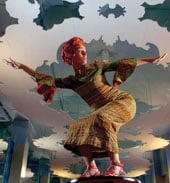It could be you…
New ideas and strategies will soon have to be drawn up for distributing what is likely to be a growing pool of post-Olympics arts Lottery money. Jeremy Newton considers the options

Having been involved in the establishment of both the Arts Lottery Fund (at Arts Council England [ACE]) and the National Endowment for Science, Technology and the Arts (NESTA), it’s interesting to remember that those two developments took place at times that were conducive to radical change. After 11 years of the Thatcher Government, John Major was able to capitalise on an appetite for new ideas by launching the National Lottery in 1994. Similarly, after 18 years of Tory government, one of the first legislative actions of the new Labour government was the 1998 National Lottery Act, creating NESTA. With the recent General Election and the comprehensive realignment of public expenditure, we have clearly arrived at another key turning point when the achievements of the Lottery to date will be reviewed and new ideas will be at a premium. The post-2012 destination of Lottery funds currently allocated to the Olympics, the achievements of the Big Lottery Fund, the apportionment of funds across Good Causes, the strategy for allocating Lottery funds within the arts, and much else besides are all under scrutiny and up for grabs.
REASONS TO BE CHEERFUL?
The arts may well stand to gain substantially from this process, but only if the case for extra funds can be as clear, compelling and timely as the argument for Capital Funding in 1994 or for the nurturing of creative talent across the domains of art, science and technology in 1998. With the Government’s plans to increase the arts share of the Lottery, the planned reduction in the amount transferred from the Lottery pot to the Olympics in 2012/13 (down to zero in 2013/14) and Camelot’s own optimism about Lottery sales in 2012 and beyond, there is room for some optimism about the possibility of increased Lottery resources for the arts.
However, it is important to acknowledge the radically changed economic climate and the likelihood of intense competition for whatever resources might be available. In particular, given the combination of these two factors, there will certainly be a high level of demand for ‘emergency funding’ to alleviate the impact of reductions in other budgets (such as ACE Grant-in-Aid, local government funding, business support and private patronage). This is likely to create conflicts: there is a strong case, for example, for allocating priority to nurturing the artists and audiences of tomorrow rather than augmenting subsidy for those of today. Providing Lottery funds for areas such as artists in schools; building links between schools and arts organisations; widening access to leading colleges and conservatoires of dance, drama, music, art and film, and so on, would represent a marked shift away from earlier priorities in an important and exciting direction. But an equally strong case can (and will) be made for ‘damage limitation’ and protecting the existing arts infrastructure from the worst effects of the current and projected economic climate.
GETTING PRIORITIES STRAIGHT
Given that we are surveying a landscape dotted with as many threats as opportunities, two areas of priority suggest themselves (in addition to the education-focused one mentioned above): firstly, ‘damage limitation’ funding in a form designed to enhance longer-term sustainability and to ‘invest in the future’, rather than to provide short-term ‘quick-fixes’. This may allow scope for endowment funding, piloting of new revenue streams, something similar to the original intentions of ‘stabilisation funding’, etc… Secondly, funding of activity more closely aligned towards addressing wider economic issues, such as generating employment, business start-up/growth and the environmental/climate change agenda. This would allow the exploration of new forms of support and development in creative industry sectors such as design, architecture, fashion and music; investment in research and development and new technology; support for growth and commercialisation; and apprenticeships and job creation.
Other candidates for ‘Lottery attention’ might include skills and career development for the creative and cultural industries (linking into the wider need to promote interest in the ‘STEM’ subjects of Science, Technology, Engineering and Maths, all of which have direct and increasing value not only to the economy as a whole but specifically to the creative industries themselves; and seed investment to develop the position of the arts within the digital economy (where recent experiments with live cinema relays and computer downloads of filmed performances, orchestra ‘own-labels’, digitisation of arts buildings and new business models for arts activity of all kinds offer an entirely new set of approaches to dissemination, distribution and widened access).
In short, there is real additional money to play for, but the arts will only win a decent share of it with a set of strong, imaginative, future-focussed ideas for how the money might be spent. These ideas will need to be connected up to the broader political, economic and social agenda, and the best place to start would be with the nation’s children and young people – invest in them as artists and art-lovers and a whole lot will fall into place.
Join the Discussion
You must be logged in to post a comment.